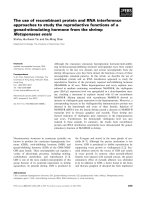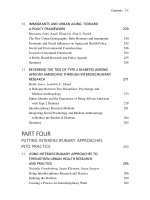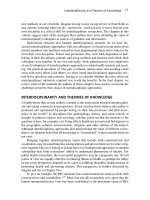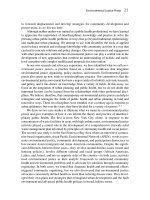Microfluidics and microarray based approaches to biological analysis 3
Bạn đang xem bản rút gọn của tài liệu. Xem và tải ngay bản đầy đủ của tài liệu tại đây (453.36 KB, 33 trang )
Chapter 3
CHAPTER 3 MICROARRAY-BASED SCREENING OF KINASE ACTIVITY
3.1 Introduction
3.1.1 Protein Phosphorylation
Phosphorylation of proteins by kinases is one of the most important mechanisms for
regulation of cell function.
1,2
It has been estimated that more than one third of all
proteins can be modified by phosphorylation in mammalian cells, and that more than 1
% of the genes in the human genome encode protein kinases.
3
A major challenge in the
signal transduction field has been to define sequence, structural and mechanistic
features responsible for the substrate selectivity, regulation and cellular function of
individual protein kinases. Additionally, there is considerable interest in identifying
potent and selective inhibitors for each of these enzymes since these can be used as
potential therapeutic agents in the treatment of cancer, heart disease and immune-
related conditions.
4
However, few kinases have yet been identified and fully
characterized.
One of the most important features of protein kinases is their substrate specificity,
which to a large extent is determined by the primary sequence around the
phosphorylation site of their targeting proteins. As a result, a number of methods have
been developed to identify potential kinase substrates, including combinatorial
synthesis of peptide libraries on membrane using the SPOT technology,
5
one-bead-
one-compound peptide libraries,
6
positional-scanning combinatorial libraries,
7
and
peptide libraries using affinity-column selection.
8
65
Chapter 3
3.1.2 Microarray-Based High Throughput Kinase Study
More recently, peptide-based microarrays have also been developed
for screening of
kinase activity.
9,10,11,12
Compared to the SPOT technology, the much higher density
of spots allowed in a peptide array makes it possible for simultaneous screenings of
tens of thousands of kinase substrates on a 3” x 1” glass surface. Zhu et al analyzed the
activity of 119 of the 122 yeast kinases using microwells made of PDMS.
10
They
covalently attached the substrates to the microwells and incubated them with the
kinase and radioactively-labeled ATP. After phosphorylation had taken place, the
kinases and ATP were washed away and the microwells scanned. Most of the other
array-based kinase assays rely on standard microscope slides as support. Schreiber et
al, in a proof-of-concept experiment, arrayed three kinase substrates onto glass slides
and incubated them with different kinase solutions.
9
Incorporation of radioactively
labeled ATP was also used for detection. A very similar approach was also used by
Falsey et al.
11
Surface plasmon resonance was also recently reported for detection of
kinase activity.
12
3.1.3 Issues to Be Addressed
Peptide-based microarray is one of the most promising technologies for the high
throughput screening of protein kinase activity. Because of the high density of enzyme
substrates arrayed on a microscope slide, one can potentially screen for a wide range of
substrates and kinase activity as well as antigen-antibody or ligand-receptor interaction
and so on.
13,14
However, the development of these technologies is still in its infancy
since some issues remain to be addressed. For efficient kinase assay to be performed,
the kinase substrates need to be arrayed in a site-specific fashion so that efficient and
optimum phosphorylation reaction can take place. Most peptide and protein arrays
66
Chapter 3
reported so far use either non-specific, covalent immobilization of molecules to the
slide or not very stable site – specific immobilization strategies. NHS-functionalized
slides and epoxide functionalized slides were respectively used by Zhu et al and
Schreiber et al to immobilize kinase substrates via their amine groups, resulting in
random immobilization of proteins onto the glass surface.
9,10
New strategies were
developed by Falsey et al as well as Housman et al for site-specific immobilization of
kinase substrates.
11,12
However, in the first case, this resulted in an oxime bond which
is relatively unstable, and the five-membered-ring thiazolidine may present
immobilized peptides in an unfavorably restricted orientation to interact with their
targeting proteins. In the second case, the developed strategy required the conjugation
of peptides with an unnatural cyclopentadiene moiety, making it synthetically
challenging and not easily accessible. Another issue to be addressed is the detection of
substrate phosphorylation. To date, most of the peptide arrays developed for kinase
assay require the use of radioactive
32
P for detection of substrate phosphorylation,
presenting a serious threat to human health.
9,10
Furthermore, the long exposure time
(usually hours to days) needed for sensitive detection of
32
P upon substrate
phosphorylation does not lend itself to high-throughput applications.
3.2 Results and Discussion
3.2.1 Fluorescent Antibody-Based Detection of Kinase Substrate Phosphorylation
All peptide arrays developed to date for kinase assay require the use of radioactive
32
P
for detection of substrate phosphorylation, presenting a potential risk to human health.
Furthermore, the long exposure time needed for sensitive detection of
32
P upon
67
Chapter 3
substrate phosphorylation does not lend itself to high-throughput applications.
Fluorescently labeled antibodies have been reported, in a microarray format, for
detection of protein/protein, protein/peptide and protein/small molecule interactions
9
as
well as cell assay.
11
The use of poly- and monoclonal antibodies directed against
phosphoamino acids have been widely used to detect phosphorylated proteins in gel
electrophoresis.
15
This method is extremely sensitive since antibodies can detect as
little as a few fmol of phosphorylated epitopes.
16
In addition, due to the highly specific
nature of antibody-antigen recognition, little or no cross-reactivity of one
phosphoamino acid antibody (e.g. anti-phosphotyrosine) to other phosphoamino acids
or non-phosphorylated amino acids was observed.
17
3.2.1.1 Qualitative Fluorescent Antibody-based Detection of Phosphorylated
Amino Acids and Peptides
In order for peptide arrays to gain wider popularity for kinase screenings, it is
imperative to develop an alternative detection method that poses less health risks than
32
P, yet provides similar sensitivity for efficient detection of kinase activity in a
microarray format. In order to determine whether FITC-labeled anti-phosphoamino
acids could be used to detect phosphorylation of kinase substrates in a peptide array,
we first tested their use for detection of phosphorylated amino acids and peptides. Both
phosphorylated and non-phosphorylated tyrosine amino acids were spotted on an
amine functionalized glass slide, and detected using FITC-labeled anti-
phosphotyrosine and anti-phosphoserine. As shown in Figure 3.1, only the FITC-
labeled anti-phosphotyrosine was able to detect the phosphotyrosine immobilized on
the slide. Neither binding of anti-phosphoserine to phosphotyrosine, nor that of anti-
phosphotyrosine to non-phosphorylated tyrosine, was observed. We also attempted to
68
Chapter 3
detect the protected phosphotyrosine with both FITC-labeled antibodies and no
binding was observed.
a)
Tyr P-Tyr
Tyr P-Tyr
b)a)
Tyr P-TyrTyr P-Tyr
Tyr P-TyrTyr P-Tyr
b)
Figure 3.1. Fluorescent antibody-based detection of phosphorylated amino acids.
Phosphorylated (p-Tyr) and non-phosphorylated tyrosine (Tyr) were arrayed onto
amine-functionalized slides and probed with (a) FITC-labeled anti-phosphotyrosine
and (b) and anti-phosphoserine
The same experiment was then repeated with phosphorylated peptides instead of amino
acids. Both phosphorylated and non-phosphorylated peptide substrates of p60 tyrosine
kinase (YIYGSFK) were synthesized with an additional CGG N-terminal linker for
immobilization purpose. Both peptides were arrayed onto glass slides functionalized
with glyoxylic acid.
11
After blocking with BSA, the slides were probed for
phosphorylation by incubation with FITC-labeled anti-phosphotyrosine and anti-
phosphoserine for an hour. Only anti-phosphotyrosine was able to detect the
phosphorylated p60 substrate as shown in Figure 3.2, confirming the high specificity
of this antibody-based detection of tyrosine phosphorylation.
69
Chapter 3
a) b)
p60 P-p60 p60 P-p60
a) b)
p60 P-p60p60 P-p60 p60 P-p60p60 P-p60
Figure 3.2. Fluorescent antibody-based detection of phosphorylated peptides.
Phosphorylated (P-p60) and non-phosphorylated (p60) substrates (CGG-YIYGSFK) of
the p60 tyrosine kinase were arrayed onto slides functionalized with glyoxylic acid and
probed with (a) FITC-labeled anti-phosphotyrosine and (b) FITC-labeled anti-
phosphoserine.
3.2.1.2 Quantitative Fluorescent Antibody-Based Detection of Peptide
Phosphorylation
Fluorescent antibodies allows for the rapid screening of phosphorylated amino acids
and peptides. However, substrate phosphorylation levels must be correlated with
measured fluorescence intensity. Increasing ratio of phosphorylated to non-
phosphorylated p60 kinase substrates were mixed with a combined constant
concentration, and were arrayed onto thioester-functionalized slides (see paragraph
3.2.2.2). After a 3-hour incubation, ensuring the total binding of the substrates, the
slides were probed with the FITC-labeled anti-phosphotyrosine antibody for 1 hr. The
intensity of the spots increased as the ratio of phosphorylated substrate to non-
phosphorylated p60 substrate increased (Figure 3.3). The fluorescence of any
fluorescent substrate is directly proportional to its concentration, and a graph of
fluorescence intensity versus the ratio of phosphorylated p60 substrate (Figure 3.4)
showed a linear correlation for a p60 ratio ranging from 0 to 100 %, demonstrating the
feasibility for on-chip quantitation of phosphorylated peptides using this method.
70
Chapter 3
1/100
25/75
50/50
75/25
100/0
1/100
25/75
50/50
75/25
100/0
Phosp60/p60 ratio
1/100
25/75
50/50
75/25
100/0
1/100
25/75
50/50
75/25
100/0
1/100
25/75
50/50
75/25
100/0
1/100
25/75
50/50
75/25
100/0
Phosp60/p60 ratio
Figure 3.3. Fluorescence of increasing ratios of phosphorylated to non-phosphorylated
p60 substrate. Increasing ratios of phosphorylated/non-phosphorylated GGC p60
peptides, with a combined constant concentration, were arrayed onto thioester-
functionalized slides, incubated for 3 hours, and probed with the FITC-labeled anti-
phosphotyrosine antibody for 1 h.
Fluorescence intensity vs amount of phosphorylated
substrate
0
5000
10000
15000
20000
25000
0 0.5 1 1.5 2 2.5 3 3.5
p60 substrate concentration (mM)
Fluorescence intensity
Figure 3.4. Fluorescence intensity vs amount of phosphorylated substrate. Increasing
ratios of phosphorylated/non-phosphorylated GGC p60 peptides, with a combined
constant concentration, were arrayed onto thioester-functionalized slides incubated for
3 hours, and probed with the FITC-labeled anti-phosphotyrosine antibody for 1 hr.
3.2.1.3 Fluorescent Antibody-Based Detection of Kinase Activity
Current array-based kinase assays are time consuming due to the long time required for
detection. A detection relying on fluorescent antibodies is much faster, and a very fast
screening of kinase activity can be performed by first incubating the slides with kinase,
and subsequently with the fluorescent antibodies (Scheme 3.1).
71
Chapter 3
PO
4
Kinase
PO
4
PO
4
PO
4
PO
4
KinaseKinase
PO
4
PO
4
PO
4
PO
4
Scheme 3.1. Very fast screening of kinase activity. Glass slides were arrayed with
kinase substrates and after substrate phosphorylation with kinase, the phosphorylation
level are rapidly detected with fluorescent antibodies.
The two substrates of the serine protein kinase PKA and tyrosine kinase p60,
ALRRASLG and YIYGSFK respectively, were synthesized with an additional GGC
linker. Both peptides were spotted onto the same slides functionalized with glyoxylic
acid. Following blocking with BSA, the slides were first incubated for an hour with the
corresponding kinase (p60 tyrosine kinase for Figure 3.5 a) and PKA kinase for
Figures 3.5 b)), and then detected with FITC-labeled anti-phosphotyrosine and anti-
phosphoserine. Only anti-phosphotyrosine was able to detect the tyrosine kinase
activity of p60. Similarly, only anti-phosphoserine was able to detect the serine kinase
activity of PKA. The complete absence of cross-detection between the two FITC-
labeled antibodies demonstrates the high specificity of the antibodies against their
corresponding phosphorylated amino acids/peptides.
72
Chapter 3
a)
PKA p60 PKA p60
b)a)
PKA p60 PKA p60
b)
Figure 3.5. Detection of kinase activity with FITC-labeled antibodies. PKA (left
panel) and p60 (right panel) substrates were arrayed onto glyoxylic acid-functionalized
slides. Slide a) was incubated with p60 kinase and slide b) with PKA. Slides were
probed with both FITC-labeled anti-phosphotyrosine and FITC-labeled anti-
phosphoserine, incubation of slide a) with only FITC-labeled anti-phosphotyrosine is
shown and incubation of slide b) with only and FITC-labeled anti-phosphoserine is
shown.
The concentration- and time-dependent detection of peptide phosphorylation on chip
were then studied. Decreasing concentrations (3 mM, 1 mM, 0.3 mM and 0.1 mM) of
GGC p60 substrate in PBS, pH 7.4, were arrayed onto a thioester-containing glass
slide and incubated with p60 kinase for increasing periods of time (1, 5 and 12 hrs).
The slides were incubated with the FITC-labeled anti-phosphotyrosine for 1 hour,
washed, dried, scanned (Figure 3.6) and the fluorescence intensity of the spots was
measured (Figure 3.7).
73
Chapter 3
3 mM 1 mM 0.3 mM 0.1 mM 3 mM 1 mM 0.3 mM 0.1 mM
Figure 3.6. Antibody-based fluorescence measurement of kinase activity: Decreasing
concentrations (3 mM, 1 mM, 0.3 mM and 0.1 mM) of GGC p60 substrate in PBS, pH
7.4, were arrayed on thioester slides and incubated with the p60 kinase for increasing
period (1, 5 and 12 hrs). The slides were incubated with the FITC-labeled anti-
phosphotyrosine for 1 hour, washed, dried, scanned and the fluorescence intensity of
the spots measured.
The concentration-dependent kinase activity was confirmed by plotting the observed
fluorescence intensity over the differing concentrations of the peptide spotted on the
slide following the same incubation time (5 hrs) with the corresponding kinase (Figure
3.7). It was found that the fluorescence intensity was directly proportional to the
concentration of the substrate, showing the feasibility for determination of
concentration-dependent kinase activity. Using this antibody-based fluorescence
detection, kinase phosphorylation was readily detected even with 0.1 mM – which,
with a spot size of 1 nL, corresponds to ~0.1 pmol of the peptide substrate. By
increasing the scanning time or changing the dye used to label the antibody, a 10- to
100-fold lower detection limit should be obtainable.
74
Chapter 3
concentration-dependant kinase activity
R
2
= 0.997
0
5000
10000
15000
20000
25000
0 0.5 1 1.5 2 2.5 3
p60 substrate concentration (mM)
Fluorescence intensity
Figure 3.7. Concentration-dependent kinase activity. Peptide solutions of increasing
concentrations were spotted, incubated with the kinase solution for 5hrs and the
fluorescence intensity measured.
The time-dependent kinase activity was also determined by plotting the observed
fluorescence intensity obtained after incubation of the peptide (3 mM spotting
concentration) with the kinase solution for increasing period of time (Figure 3.8). The
result indicated that the fluorescence intensity as a result of peptide phosphorylation
correlates well with kinase incubation time. This, together with our previous findings
that the amount of phosphorylated substrates is linearly proportional to the
fluorescence intensity detected using the FITC-labeled antibodies (Figure 3.4),
indicates the feasibility of time-dependent on-chip quantitation of kinase activity.
Furthermore, in sharp contrast with existing radioactive
32
P detection methods, this
antibody-based fluorescence detection method is not only safe and highly sensitive, but
also requires much shorter time (1 h or less) for detection of phosphorylated amino
acids and peptides on chip.
75
Chapter 3
Time dependent kinase activity
0
5000
10000
15000
20000
25000
0 5 10 15
Time (hours)
Fluorescence Intensity
Figure 3.8. Time-dependent kinase activity. Peptide solutions (5 mM spotting
solution) were arrayed, incubated with the kinase solution for increasing periods of
time and the fluorescence intensity measured.
3.2.2 Developing New Site-Specific Immobilization Strategies for Efficient Array-
Based Screening of Kinase Activity
Peptide-based microarray is one of the most promising techniques that allows for
potential miniaturized, high-throughput screenings of enzymatic activities, antigen-
antibody or ligand-receptor interaction and so on. Proteins have well-defined three-
dimensional structures, and for efficient screening of protein-protein, protein-peptide,
protein-small molecules interactions, or enzyme activity, proteins need to be arrayed in
a site-specific orientation in order to ensure they retain their activity. Peptides do not
typically possess well-defined 3-dimensional structures, but immobilization of
peptides on glass surfaces with a correct orientation is still imperative in order for the
peptides to interact effectively with their targeting proteins. Most peptide microarrays
used for kinase screening use non-specific, covalent immobilization - kinase substrates
were attached to NHS functionalized slides
9
and epoxide functionalized slides
10
via
their amine functionalities - thereby failing to address this issue. The site-specific
ligation of glyoxylyl peptides onto glass slides functionalized with a semi-carbazide
76
Chapter 3
sol-gel layer was recently reported.
18
Falsey et al. recently reported chemoselective N-
terminal attachment of peptides onto a slide.
11
Using glass slides functionalized with
glyoxylic acid, they were able to immobilize N-terminally cysteine-containing peptides
via oxime-bond or thiazolidine-ring ligation reaction. This strategy, while elegantly
designed to site-specifically immobilize peptides, may be of limited applications as the
oxime bond is relatively unstable, and the five-member-ring thiazolidine may present
immobilized peptides in an unfavorably restricted orientation to interact with their
targeting proteins. Houseman et al have recently reported the use of Diels-Alder
reaction for site-specific immobilization of peptides onto glass slides.
12
However, this
method requires the conjugation of peptides with an unnatural cyclopentadiene moiety,
making it synthetically challenging and not easily accessible.
In order for kinase assay to be performed efficiently and accurately in a microarray
format, the substrates need to be attached at their terminal residues via a site-specific
immobilization method. Two new strategies based on avidin-biotin interaction and on
native chemical ligation were hence developed for site-specific immobilization of
kinase substrates onto functionalized glass slides.
3.2.2.1 Site-Specific Immobilization via Avidin-Biotin Interaction
Taking advantages of the interaction between avidin and biotin, one of the strongest
non-covalent known interactions (K
d
= 10
-15
M), one can immobilize N-terminally
biotinylated peptides onto a glass slide functionalized with avidin. Avidin is also a
highly stable protein that maintains its functions even under extremely harsh
conditions,
19
and therefore is an ideal candidate for slide functionalization. Although
the biotin-avidin interaction is well studied, it has however never been reported for the
site-specific immobilization of peptides onto glass slides.
77
Chapter 3
3.2.2.1.1 Glass Slide Functionalization
Glass slides were functionalized with avidin by first derivatizing the slides with an
epoxide containing silane and then with avidin. Avidin is very stable and glass slides
can be functionalized in advances and stored at room temperature for long period of
times before being spotted.
3.2.2.1.2 Application to Kinase Array
The extremely high binding affinity of biotin towards avidin allows for tight and
efficient site-specific immobilization of the biotinylated peptide on the glass slide
(Scheme 3.2). In addition, since the avidin-biotin binding is instantaneous, only a very
short incubation time was needed for the immobilization of the peptide onto the slide,
in contrast with other existing methods which require long incubation times for
immobilization to occur.
10,11,12
The layer of avidin on the slide surface also provides a
molecular layer between the glass surface and proteins interacting with the
immobilized peptides, thereby eliminating the BSA blocking and minimizing
nonspecific binding on the glass surface.
S
H
N
N
H
O
S
H
N
N
H
O
Scheme 3.2. Site-specific immobilization of biotinylated substrates onto avidin
functionalized slides.
78
Chapter 3
To demonstrate the feasibility of this approach, an N-terminally biotinylated Janus
Tyrosine Kinase (JAK) substrate with an additional GG spacer (Biotin-GG-
KGTGYIKTG) was dissolved in PBS, pH 7.4, and arrayed on the avidin slide. After a
few minutes of incubation, the slide was washed with PBS, water and then dried.
Successful detection of the JAK peptide was accomplished by incubation for 1 hour
with a Cy3-labeled antibody raised against JAK as shown in Figure 3.9.
Figure 3.9. Site-specific immobilization of kinase substrate via avidin-biotin
interaction. Biotinylated JAK peptide was arrayed onto a glass slide functionalized
with avidin and after a very short incubation, and washing, was probed with a Cy3-
labeled antibody raised against this peptide.
3.2.2.2 Site-Specific Immobilization via Native Chemical Ligation
3.2.2.2.1 Description
Various chemical ligations were developed in the early 90s in order to help in the
synthesis of long non-protected peptides. Uniquely reactive functionalities are
incorporated into each peptide by chemical synthesis to allow for the site-specific
reactions of unprotected peptides. This chemical ligation has proven to be easy to
implement and a variety of ligation chemistries have been used, however resulting in
unnatural groups such as oxime,
20
thiazolidine ring,
21
thioester. However, these
79
Chapter 3
entailed the formation of unnatural structures at the site of ligation between two
peptide segments. On the contrary, the native chemical ligation, developed by Kent,
takes place between the N-terminal cysteine of one peptide and the thioester of a
second peptide, eventually resulting in the formation of a stable peptide bond (Scheme
3.3).
Peptide 1Peptide 1
Peptide 2Peptide 2
Peptide 1Peptide 1
Peptide 1Peptide 1
Peptide 2Peptide 2
Peptide 2Peptide 2
O
SR
+
H
3
N
O
HS
HN
R'
S
O
O
H
2
N
H
N
N
H
O
HS
O
R'
Scheme 3.3. Principle of Native Chemical Ligation.
A feature of the native chemical ligation is that ligation occurs at a unique N-terminal
cysteine even if the two peptides contain other cysteine residues. Uniquely, the
thioester-linked intermediate involving the N-terminal cysteine residue is able to
undergo nucleophilic rearrangement by a highly favorable intramolecular mechanism;
this step is irreversible and gives a polypeptide product; which is linked by a stable
native peptide bond.
80
Chapter 3
3.2.2.2.2 Functionalization of Glass Slide with Thioester
Amine functionalized slides were reacted with succinic anhydride, and the obtained
carboxylic moiety was activated with NHS and reacted overnight with
benzylmercaptan to generate thioester functionalized slides (Scheme 3.4).
NH
2
O
Si
O
O
O
Si
O
O
O
Si
O
O
O
Si
O
O
O
O
O
NH
O
COOH
NH
O
CONHS
SH
NH
O
C
S
O
TBtu/DIEA/NHS, 1:2:1, DMF
NaBO
3
pH9, DMF
20 min
3h
DIEA
TBTU / DIEA/NHS, 1:2:1, DMF
NH
2
O
Si
O
O
O
Si
O
O
O
Si
O
O
O
Si
O
O
O
O
O
NH
O
COOH
NH
O
CONHS
SH
NH
O
C
S
O
TBtu/DIEA/NHS, 1:2:1, DMF
NaBO
3
pH9, DMF
20 min
3h
DIEA
NH
2
O
Si
O
O
O
Si
O
O
O
Si
O
O
O
Si
O
O
O
O
O
NH
O
COOH
NH
O
CONHS
SH
NH
O
C
S
O
TBtu/DIEA/NHS, 1:2:1, DMF
NaBO
3
pH9, DMF
20 min
3h
DIEA
TBTU / DIEA/NHS, 1:2:1, DMFTBTU / DIEA/NHS, 1:2:1, DMF
Scheme 3.4. Thioester functionalization of glass slides
3.2.2.2.3 Applications of the Native Chemical Ligation to Kinase Arrays
Immobilization of peptides using native chemical ligation is highly specific since only
the terminal cysteine would react with the thioester on the glass surface to form a
stable native peptide bond (Scheme 3.5). Presence of other reactive amino acid side
chains, including internal cysteines, is tolerated. This immobilization method differs
from those developed by McBeath et al where either any sulfhydryl group may react
81
Chapter 3
with maleimide-functionalized slides,
22
or any nucleophilic group (-NH
2
, -SH, -OH)
may react with NHS
9
- or epoxy-functionalized slides.
10
Formation of a stable peptide
bond between the immobilized peptides and the glass surface via native chemical
ligation is also in contrast with that developed by Falser et al where an unstable oxime
bond or a rigid thiazolidine ring was formed.
11
O
Si
O
O
NH
O
C
S
O
CH
NH
3
+
-
S
C
O
O
Si
O
O
NH
O
C
O
S
CH
NH
2
C
O
O
Si
O
ONH
O
C
NH
O
SH
O
Peptide
Peptide
Peptide
Scheme 3.5. Site-specific immobilization, via native chemical ligation, of N-terminal
containing cysteine peptides onto thioester slides.
A JAK peptide (KGTGYIKTG) and the phosphorylated p60 peptide (YIYGSFK) were
synthesized with an N-terminal cysteine and two glycines as linker. These were
dissolved in PBS, pH 7.4, and spotted onto the thioester slide. Following incubation
for 5 hours, the peptides were successfully detected with their corresponding
fluorescently-labeled antibodies (Figure 3.10 a and b), further demonstrating the
compatibility of this immobilization method with microarray-based kinase assay.
82
Chapter 3
a)
b)
a)
b)
Figure 3.10. Site-specific immobilization of kinase substrates via native chemical
ligation. N-terminal cysteine containing peptides were arrayed on thioester
functionalized slides and probed with fluorescent antibodies. (a) Immobilized JAK
peptide probed with Cy3-labeled anti-JAK. (b) Immobilized phosphorylated p60
peptide probed with FITC-labeled anti-phosphotyrosine.
3.2.2.2.4 Surface Study of Thioester Functionalized Slides
Additional studies were conducted to further evaluate this novel thioester-containing
glass surface. Cysteine-containing fluorescein
1
(Figure 3.11) was dissolved in PBS, pH
7.4, serially diluted and arrayed onto thioester slides. Following overnight incubation,
the slides were washed with PBS, water, dried and scanned. It was observed that the
fluorescence intensity reaches saturation with 3 mM cysteine fluorescein, indicating
the equivalent loading capacity of thioester on the glass surface (Figure 3.12).
Figure 3.11. Structure of cysteine-containing fluorescein
O
NH
N
H
HO
O
CO
2
H
H
2
N
HS
O
O
1
This compound was synthesized by Dr Zhu, Chemistry Department, NUS
83
Chapter 3
9 mM
1 mM
3 mM
0.3 mM
0.1mM
9 mM
1 mM
3 mM
0.3 mM
0.1mM
Figure 3.12. Saturation studies of thioester slides using different spotting
concentrations of cysteine-containing fluorescein.
In order to evaluate the time needed for efficient immobilization of peptides, different
concentrations of the cysteine-containing fluorescein in PBS (pH 7.4) were spotted and
incubated for increasing periods of time (Figure 3.13). It was observed that the reaction
took place within the first 30 minutes of incubation. After 3h of incubation, spots
corresponding to lower concentrations were eventually observed and the intensity
reached saturation, indicating the completion of the native chemical ligation reaction,
hence the complete peptide immobilization.
30 min
1 hr
3 hrs
3 mM
1 mM
0.3 mM
30 min
1 hr
3 hrs
3 mM
1 mM
0.3 mM
Figure 3.13. Rate of on-chip chemical ligation reaction. Increasing amounts of
cysteine-containing fluorescein were arrayed on thioester functionalized slides and
incubated for increasing period of time.
84
Chapter 3
3.2.2.2.5 PEGylated Thioester Functionalized Slides
BSA is commonly used as a blocking agent to remove non-specific binding of proteins
to the glass surface. However, it cannot be used directly in peptide-based arrays,
presumably because it obscures the molecules of interest.
9
In order to solve this
problem, slides functionalized with BSA containing reactive NHS were used to
immobilize peptides.
9
However, peptides randomly reacted with NHS on the slide,
resulting in non-specific immobilization on the surface. PEG is known to remove non-
specific binding of proteins to glass and glass slides were derivatized glass slides with
two types of PEG followed by treatments with other chemicals to give thioester
surfaces containing a PEG layer.
Two different functionalized PEG were used to functionalize the slides. In a first
approach, slides were functionalized with an epoxide containing silane and amine PEG
was subsequently used (Scheme 3.6). The thioester group was then obtained as
previously described (Scheme 3.4). In a second approach, slides were functionalized
with an amine silane, and NHS PEG was subsequently used (Scheme 3.7). This second
protocol was much shorter, since the NHS PEG can be reacted with benzyl mercaptan
to obtain the thioester functionalized slides.
85
Chapter 3
O
Si
O
O
SH
PEG
NH
2
PEG
O
H
2
N
NNH
2
O
Si
O
O
PEGN
O
O
O
O
Si
O
O
NH
O
COOH
O
Si
O
O
PEGN
NH
O
CONHS
O
Si
O
O
PEGN
NH
O
C
S
O
+
DIEA 5 hrs
PBS, pH 7.4
TBtu/DIEA/NHS, 1:2:1, DMF
NaBO
3
pH9, DMF
20 min
TBTU/ DIEA/N HS,1:2:1, DM F
O
Si
O
O
SH
PEG
NH
2
PEG
O
H
2
N
NNH
2
O
Si
O
O
PEGN
O
O
O
O
Si
O
O
NH
O
COOH
O
Si
O
O
PEGN
NH
O
CONHS
O
Si
O
O
PEGN
NH
O
C
S
O
+
DIEA 5 hrs
PBS, pH 7.4
TBtu/DIEA/NHS, 1:2:1, DMF
NaBO
3
pH9, DMF
20 min
TBTU/ DIEA/N HS,1:2:1, DM FTBTU/ DIEA/N HS,1:2:1, DM F
Scheme 3.6. PEGylation of thioester slides with amine PEG
NH
2
O
Si
O
O
NH
O
Si
O
OPEG
O
SH
S
O
NH
PEG
O
O
NHS
NHS PEG
O
O
NHS
O
Si
O
O
+
DIEA
5 hrs
0.1 M NaHCO
3
, pH 9, 30 min
Scheme 3.7. PEGylation of thioester slides with NHS PEG
86
Chapter 3
The phosphorylated p60 substrate containing a CGG linker was arrayed on the two
PEG-COSR slides obtained with amine PEG and NHS PEG and probed with the
FITC-labeled anti-phosphotyrosine without any BSA blocking. Very little non-specific
binding was observed on both surfaces and the background noise was very low (Figure
3.14), presumably due to the PEG layer between immobilized peptides and the glass
surface. In addition to minimizing non-specific binding, PEG also acts as a spacer
between the slide and the immobilized peptides, which should facilitate
phosphorylation by kinase.
(a) (b)(a) (b)
Figure 3.14. Site-specific immobilization of kinase substrates via native chemical
ligation onto PEGylated thioester slides. Phosphorylated p60 peptide was spotted onto
glass slides functionalized with (a) NHS PEG and (b) Amine PEG, and probed with
FITC-labeled anti-phosphotyrosine.
3.2.3 Rapid Microarray-Based Kinase Assay
Rapid fluorescent antibody-based detection was combined with the site-specific
immobilization developed for rapid kinase assay.
87
Chapter 3
3.2.3.1 Avidin-Biotin Interaction
The biotinylated, non-phosphorylated, p60 substrate containing an additional GG
spacer (Biotin-GG-YIYGSFK) was synthesized and arrayed on avidin-functionalized
slides. Upon incubation with p60 tyrosine kinase for an hour, the slide was probed with
FITC-labeled anti-phosphotyrosine (Figure 3.15). Successful phosphorylation and
detection of the p60 substrate further demonstrate the utility of this new method for
site-specific immobilization of peptides on glass slides.
Figure 3.15. Kinase assay of site-specifically immobilized p60 substrate via avidin-
biotin interaction. Biotinylated p60 substrate was spotted onto avidin-functionalized
slide, phosphorylated with p60 kinase and then probed with FITC-labeled anti-
phosphotyrosine. Note: no BSA blocking was used in this experiment.
3.2.3.2. Native Chemical Ligation
The two non-phosphorylated CGG-containing substrates of tyrosine kinase p60 and
serine kinase PKA (CGG-YIYGSFK and CGG-ALRRASLG respectively) were
spotted onto the thioester-functionalized slide, incubated with their corresponding
kinases, and detected successfully with FITC-labeled anti-phosphotyrosine and anti-
phosphoserine (Figure 3.16), further demonstrating the compatibility of the native
chemical ligation immobilization strategy with microarray-based kinase assay.
88
Chapter 3
(a) (b)(a) (b)
Figure 3.16. Kinase assay of site-specifically immobilized p60 substrate via native
chemical ligation. (a) Non-phosphorylated p60 peptide was immobilized, treated with
p60 kinase and probed with FITC-labeled anti-phosphotyrosine. (b) Non-
phosphorylated PKA peptide was immobilized, treated with PKA kinase and probed
with FITC-labeled anti-phosphoserine.
3.2.3.3. Native Chemical Ligation with PEGylated Thioester Slides
Glass slides were functionalized with NHS-PEG and with a thioester function. The
non-phosphorylated CGG-containing p60 substrate was spotted onto the PEGylated
thioester slide, incubated with p60 kinase and probed with FITC-labeled anti-
phosphotyrosine (Figure 3.17). A positive signal with little background noise was
observed, confirming the additional advantage of the PEG slide.
Figure 3.17. Kinase assay of site-specifically immobilized p60 substrate via native
chemical ligation with PEGylated slides. Non-phosphorylated p60 peptide was spotted
onto a NHS PEGylated slide, treated with p60 kinase and probed with FITC-labeled
anti-phosphotyrosine.
89









